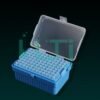Pipette Box
- Made of Polypropylene
- This Pipette Box is designed is such a way that it can hold Pipettes of different lengths
- The top of the box screws on the bot tom and the height can be adjusted by screwing the top.
| PART No. | TYPE | Pack QTY. |
| 3480 | PIPETTE BOX | 10 |
Here are common uses and purposes of pipette boxes:
- Tip Storage:
- The primary use of a pipette box is to provide a designated and organized space for storing pipette tips. The box helps protect the tips from contamination and damage when not in use.
- Preventing Contamination:
- Pipette boxes often have lids or covers to protect the pipette tips from airborne contaminants, dust, and other particles. This is particularly important in sensitive laboratory procedures where sample purity is critical.
- Sterile Storage:
- Some pipette boxes are designed to maintain sterility. They may have features such as individually wrapped tips or sterile filters to prevent contamination of the tips, making them suitable for use in aseptic environments, such as cell culture work or PCR.
- Organization:
- Pipette boxes help in organizing pipette tips, making it easy for researchers to locate the required tip size and type quickly. This is especially important in busy laboratories where efficiency and precision are crucial.
- Different Tip Sizes:
- Pipette boxes are available in various sizes to accommodate different types and sizes of pipette tips. They may have multiple compartments or wells to segregate tips based on volume or application.
- Tip Racks for Multichannel Pipettes:
- For multichannel pipettes, where multiple tips are used simultaneously, specialized tip boxes are designed with multiple rows or columns to accommodate the arrangement of tips on the pipette head.
- Tip Refilling Stations:
- Some pipette boxes can serve as refilling stations. They have a hinged lid or an open design, allowing users to easily replenish the tips without removing the box from the pipette or the tip rack from the bench.
- Autoclaving:
- Pipette boxes are often autoclavable, allowing them to be sterilized before use. This is essential in applications where aseptic conditions are required.
- Transportation and Storage:
- Pipette boxes provide a secure means of transporting pipette tips between different areas of the laboratory. They also serve as a convenient storage solution when pipettes and tips are not in active use.
- Lab Bench Organization:
- Pipette boxes contribute to the overall organization of the laboratory bench. By keeping pipette tips in dedicated boxes, the workspace remains tidy and accessible.
- Compliance with Protocols:
- In laboratories where standard operating procedures (SOPs) or protocols are followed, using dedicated pipette boxes for specific experiments helps ensure compliance with established procedures and prevents cross-contamination.
- Protection During Storage:
- Pipette boxes protect the tips during storage, especially if they are kept for an extended period. This helps maintain the integrity of the tips and ensures accurate performance during subsequent use.
- Ergonomic Pipetting:
- Some pipette boxes are designed to facilitate ergonomic pipetting. They may have features such as tilted or hinged lids, making it easier for users to access tips without straining.







